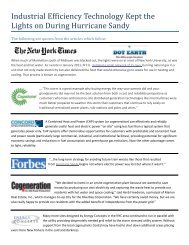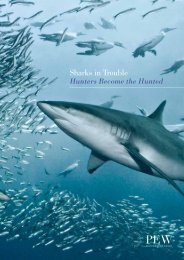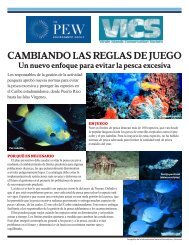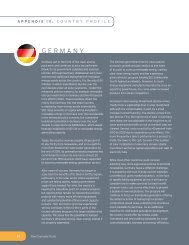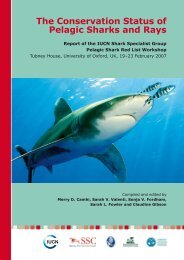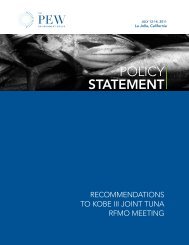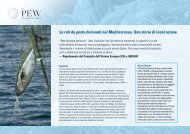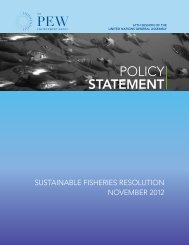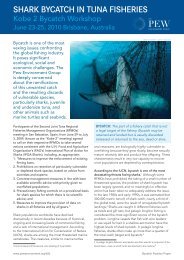Improving Global Shark Conservation - Pew Environment Group
Improving Global Shark Conservation - Pew Environment Group
Improving Global Shark Conservation - Pew Environment Group
You also want an ePaper? Increase the reach of your titles
YUMPU automatically turns print PDFs into web optimized ePapers that Google loves.
PHOTO: JIM ABERNETHY<br />
<strong>Improving</strong> <strong>Global</strong> <strong>Shark</strong> <strong>Conservation</strong>:<br />
The Need for Engagement by Both CITES and RFMOs<br />
<strong>Shark</strong> populations around the world are declining, and levels<br />
of removal are unsustainable for many species. <strong>Shark</strong>s present<br />
a complex conservation challenge because they are highly<br />
migratory, often caught on the high seas, and traded on the<br />
international market. The Convention on International Trade<br />
in Endangered Species of Wild Fauna and Flora (CITES) and<br />
Regional Fisheries Management Organizations (RFMOs) are<br />
both needed if efforts to properly manage and protect the<br />
world’s depleted shark populations are to succeed.
Figure 1: Species Range Maps and Existing <strong>Shark</strong> Protections in RFMOs<br />
Key: RFMO coverage species range overlap between the two<br />
ICCAT<br />
Scalloped hammerhead<br />
ICCAT protection<br />
Hammerhead <strong>Shark</strong>s: Only<br />
protected in the International<br />
Commission for the <strong>Conservation</strong><br />
of Atlantic Tunas (ICCAT)<br />
convention area by Contracting<br />
Parties. There are no protections in<br />
place for hammerheads under the<br />
Indian Ocean Tuna Commission,<br />
Western and Central Pacific<br />
Fisheries Commission (WCPFC),<br />
or Inter-American Tropical Tuna<br />
Commission (IATTC).<br />
NEAFC<br />
Porbeagle<br />
NEAFC protection<br />
Porbeagle <strong>Shark</strong>s: Only protected<br />
in the North East Atlantic Fisheries<br />
Commission (NEAFC) convention<br />
area by Contracting Parties.<br />
Oceanic whitetip<br />
IATTC, ICCAT, WCPFC protection<br />
WCPFC<br />
Oceanic Whitetip <strong>Shark</strong>: Only<br />
protected by the ICCAT, WCPFC,<br />
and IATTC convention areas<br />
by Contracting Parties to those<br />
agreements.<br />
ICCAT<br />
IATTC<br />
2
Combining Regional Fisheries<br />
Management With CITES<br />
Protections<br />
Few international regulations currently limit<br />
catch of sharks, allowing for tens of millions to<br />
be caught and killed every year, largely for the<br />
international shark fin trade. Although CITES and<br />
RFMOs may regulate action impacting the same<br />
species, they affect different activities and have<br />
different geographical and jurisdictional reaches.<br />
RFMOs are responsible for managing fish<br />
stocks on the high seas and those that migrate<br />
through the waters of more than a single<br />
country. Under the United Nations Fish Stocks<br />
Agreement (UNFSA), coastal and fishing states<br />
agreed to work together to conserve all species<br />
associated with or affected by their fisheries,<br />
including sharks. 1<br />
In contrast to RFMOs, CITES regulates<br />
international trade in endangered, threatened,<br />
and vulnerable species and those that may<br />
become threatened unless their international<br />
trade is regulated across the globe. CITES also<br />
provides for improved tracking, enforcement,<br />
and management of the species that would not<br />
occur in the absence of a CITES listing.<br />
RFMO <strong>Shark</strong> Measures<br />
Are Absent Or Insufficient<br />
<strong>Shark</strong>s are caught in the convention areas<br />
of many RFMOs by vessels flagged to their<br />
members. However, most RFMOs have taken<br />
little to no action to manage sharks. Some are<br />
starting to take a stronger stance in adopting<br />
conservation and management measures<br />
for sharks, but their sphere of influence has<br />
limitations: RFMOs have authority over only<br />
some of the fishing activities of vessels flagged<br />
to member States. Each RFMO manages<br />
specific species and fisheries in a particular<br />
area. Therefore, if an RFMO adopts a shark<br />
measure for a particular species, that measure<br />
CITES and RFMO regulations<br />
are complementary, and both<br />
are necessary to fully protect<br />
threatened shark species.<br />
applies only to the ocean areas within that<br />
RFMO’s convention boundaries, the fisheries<br />
managed by the RFMO, and the countries that<br />
participate in the RFMO. The geographic range<br />
of many shark species surpasses the RFMO<br />
boundaries (Figure 1), however, and many<br />
fisheries and vessels catching sharks are outside<br />
of the jurisdiction of the RFMO. As a result,<br />
directed shark fisheries and fisheries that catch<br />
sharks as bycatch frequently are not subject to<br />
RFMO management.<br />
Given that measures adopted by RMFOs do<br />
not provide all of the tools necessary to achieve<br />
progress in conserving sharks, the inclusion of<br />
certain species on the CITES Appendices is a<br />
crucial step in building an effective international<br />
framework for the conservation of sharks.<br />
Stronger Together<br />
In contrast to RFMOs, which directly regulate<br />
and manage fishing, CITES is the principal<br />
means by which the global community regulates<br />
international trade for a particular species. CITES<br />
does so by using import and export permits to<br />
regulate international trade in threatened and<br />
endangered species and those that may become<br />
threatened. Listing of species on one of the<br />
CITES Appendices complements management<br />
measures adopted by RFMOs and can improve<br />
RFMO members’ ability to monitor compliance<br />
with their shark fishing regulations.<br />
<strong>Shark</strong> fisheries are primarily driven by international<br />
trade pressure, and both fisheries and<br />
3
trade need to be carefully monitored and controlled,<br />
considering the high vulnerability of<br />
shark species to overexploitation.<br />
CITES Parties are required to maintain records<br />
of international trade in specimens listed under<br />
each of the Appendices, including the number,<br />
species, size, and sex (when available) of the<br />
specimens, and the names and addresses of<br />
the importers and exporters. Quantified trade<br />
data would provide crucial assistance to shark<br />
management efforts by RFMOs by enabling<br />
both RFMO and CITES Parties to better monitor<br />
shark catches and extraction rates by species,<br />
track trends in shark trade, project associated<br />
changes in fishing effort, and assess the efficacy<br />
of fishery management measures aimed at<br />
conserving sharks. 2<br />
CITES and RFMO regulations are complementary,<br />
and both are necessary to fully protect<br />
threatened shark species. CITES can help extend<br />
shark conservation measures to port and market<br />
States, because it includes Parties from more<br />
than 90 percent of the world’s countries (176<br />
members), and all major trading countries, and<br />
thus has the ability to regulate shark trade across<br />
the supply chain. While it is extremely important<br />
to control the trade of sharks at the port of entry,<br />
RFMOs have the ability to control both targeted<br />
fishing for sharks and adopt measures to mitigate<br />
shark bycatch.<br />
Including shark species on Appendix II of CITES<br />
would regulate international trade resulting from<br />
fisheries catching sharks. It also would assist<br />
enforcement of and compliance with RFMO<br />
measures by helping to track shark shipments<br />
and to combat illegal and unsustainable<br />
targeting of sharks and illegal trade in<br />
shark products.<br />
endnotes<br />
1<br />
The United Nations Agreement for the Implementation of the Provisions of the<br />
United Nations Convention on the Law of the Sea of 10 December 1982 relating to<br />
the <strong>Conservation</strong> and Management of Straddling Fish Stocks and Highly Migratory<br />
Fish Stocks http://www.un.org/Depts/los/convention_agreements/convention_<br />
overview_fish_stocks.htm.<br />
2<br />
International Union for the <strong>Conservation</strong> of Nature (IUCN) and TRAFFIC, The Role<br />
of CITES in the <strong>Conservation</strong> and Management of <strong>Shark</strong>s (June 2002).<br />
http://www.cites.org/common/notif/2002/ESF042A.pdf.<br />
Contact: international@pewtrusts.org<br />
Philadelphia, Pa. 19103<br />
Tel. +1 (215)575-9050<br />
Washington, D.C. 20004<br />
Tel. +1 (202)552-2000<br />
1050 Brussels, Belgium<br />
Tel. +32 (0)2 274 1620<br />
London WC1 HBY, UK<br />
Tel. +44 (0)20 7388 5370<br />
www.<strong>Pew</strong><strong>Environment</strong>.org/CITES



